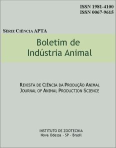Studies on 35 mixtures of grasses and legumes under two managements. I. Stablishment
Abstract
This experiment was carried out during three consecutive years in the Instituto de Zootecnia in Nova Odessa, State of São Paulo, Brazil comparing 35 mixtures of seven grasses and five legumes under two managements simulation (high and low managements). The utilized design was a complete randomized blocks with two replications beeing the species distributed in interscted strips with a total of 140 plots of 49m2 each. During the dry and wet seasons, it was evaluated the botanic composition (n.º of plants per area and ground covering), dry matter amount and crude protein percentage of the forage plants. In the midst of the grasses, under the high management, the colonial grass (Panicum maximum Jacq.) was contrasted with the others and under the low management Setaria anceps cv. Kazungula gave better results. Among the legumes, perennial soybean overcame the other species. The selection of the better mixtures was based on soil covering, dry matter amount and percentage of legumes in the mixture. Therefore, these mixtures were selected : a) high management: Colonial grass + Siratro, Gatton Panic + Siratro, Colonial grass + Perennial Soybean, Paspalum virgatum + Perennial Soybean, Setaria kazungula + Perennial Soybean and Green Panic + Centrosema; b) low management: Green Panic + Siratro, Paspalum virgatum + Siratro, Green Panic + Perennial Soybean, Paspalum virgatum + Perennial Soybean, Gatton Panic + Perennial Soybean and Setaria kazungula + Perennial Soybean. Inside the paper are the protein levels of the selected mixtures and the perspectives for the use of them for dairy and meat cattle.Downloads
Downloads
Published
Issue
Section
License
Os autores não serão remunerados pela publicação de trabalhos, pois devem abrir mão de seus direitos autorais em favor deste periódico. Por outro lado, os autores ficam autorizados a publicar seus artigos, simultaneamente, em repositórios da instituição de sua origem, desde que citada a fonte da publicação original seja Boletim de Indústria Animal. A revista se reserva o direito de efetuar, nos originais, alterações de ordem normativa, ortográfica e gramatical, com vistas a manter o padrão culto da língua e a credibilidade do veículo. Respeitará, no entanto, o estilo de escrever dos autores. Alterações, correções ou sugestões de ordem conceitual serão encaminhadas aos autores, quando necessário. Nesses casos, os artigos, depois de adequados, deverão ser submetidos a nova apreciação. As opiniões emitidas pelos autores dos artigos são de sua exclusiva responsabilidade. Todo o conteúdo deste periódico, exceto onde está identificado, está licenciado sob a Licença Creative Commons Attribution (CC-BY-NC). A condição BY implica que os licenciados podem copiar, distribuir, exibir e executar a obra e fazer trabalhos derivados com base em que só se dão o autor ou licenciante os créditos na forma especificada por estes. A cláusula NC significa que os licenciados podem copiar, distribuir, exibir e executar a obra e fazer trabalhos derivados com base apenas para fins não comerciais.













